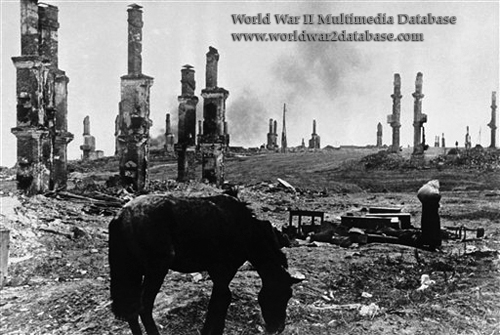| Russian women leave a shelter in Stalingrad, while a horse grazes nearby. 9,796 civilians survived the “cauldron“ to be liberated by the Red Army when Sixth Army surrendered on February 2, 1943. The Russian panje (peasant) horse was able to withstand cold better than the European stock the Germans brought with them, and by the time Sixth Army reached Stalingrad, many of its 27,000 horses had been confiscated from the panje, along with their two-wheel wagons, which looked as ancient as their design. Over three-quarters of the German Army were horse-drawn. Some 17,000 horses were evacuated a week before the Soviet Operation Uranus encircled the Sixth Army at Stalingrad. Promised 500 tons a day via an air bridge, far less than that amount arrived, and the remaining 12,000 horses were eaten. By January 1943, the Sixth Army had little food and most of the horses were dead. Witnesses described the steppe surrounding Stalingrad as covered with the carcasses of horses; the Germans ate horsemeat through the Fall of 1942. The starved animals had little flesh to consume but even that caused some soldiers to become sick; the soldiers were so starved they could no longer tolerate the concentrated protein. | |
| Image Filename | wwii0247.jpg |
| Image Size | 152.34 KB |
| Image Dimensions | 500 x 335 |
| Photographer | Unknown |
| Photographer Title | |
| Caption Author | Jason McDonald |
| Date Photographed | December 18, 1942 |
| Location | |
| City | Stalingrad |
| State or Province | Stalingrad Oblast |
| Country | Soviet Union |
| Archive | |
| Record Number | |
| Status | Caption ©2009, ©2024 MFA Productions LLC Please Do Not Duplicate or Distribute Without Permission |

Author of the World War II Multimedia Database

